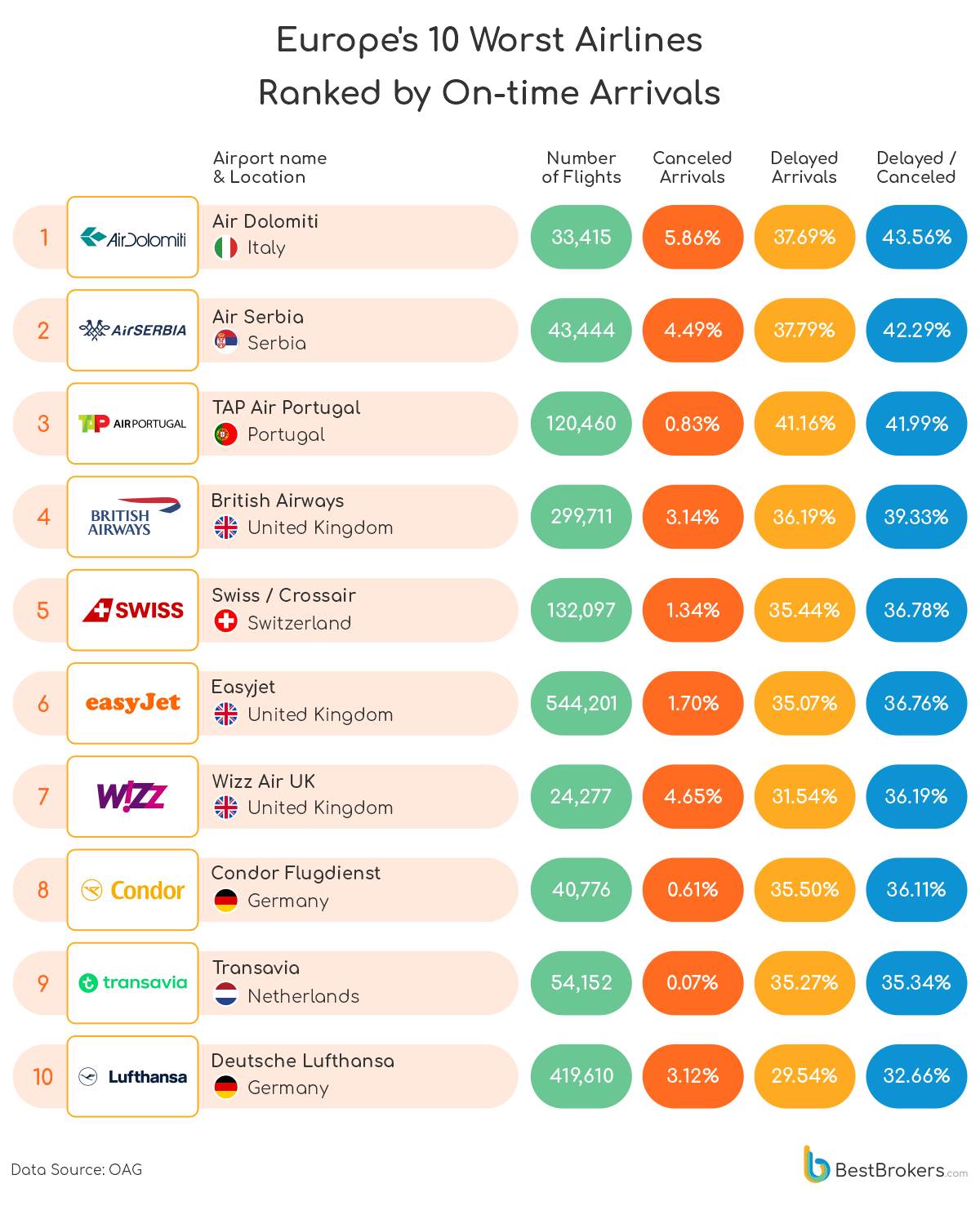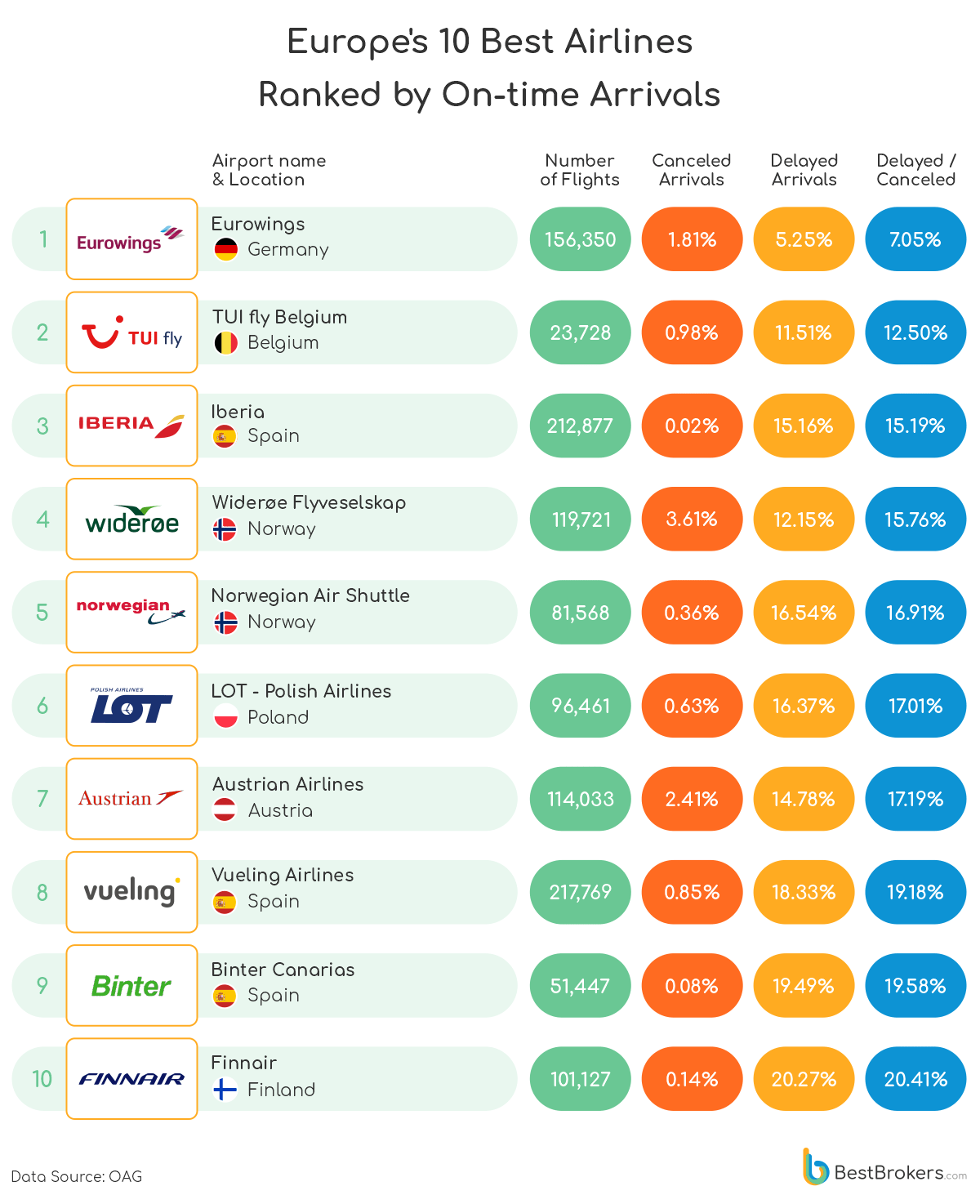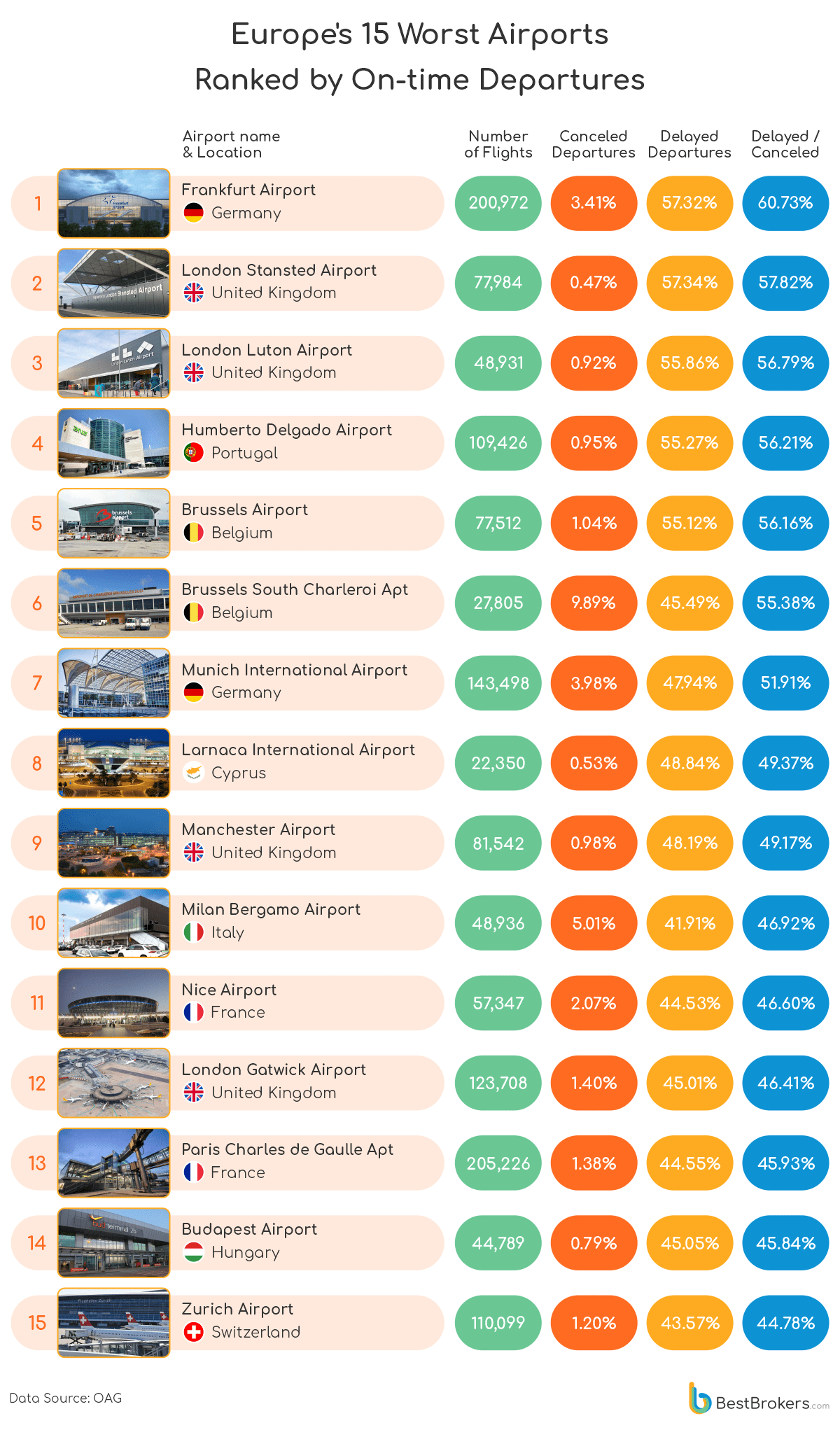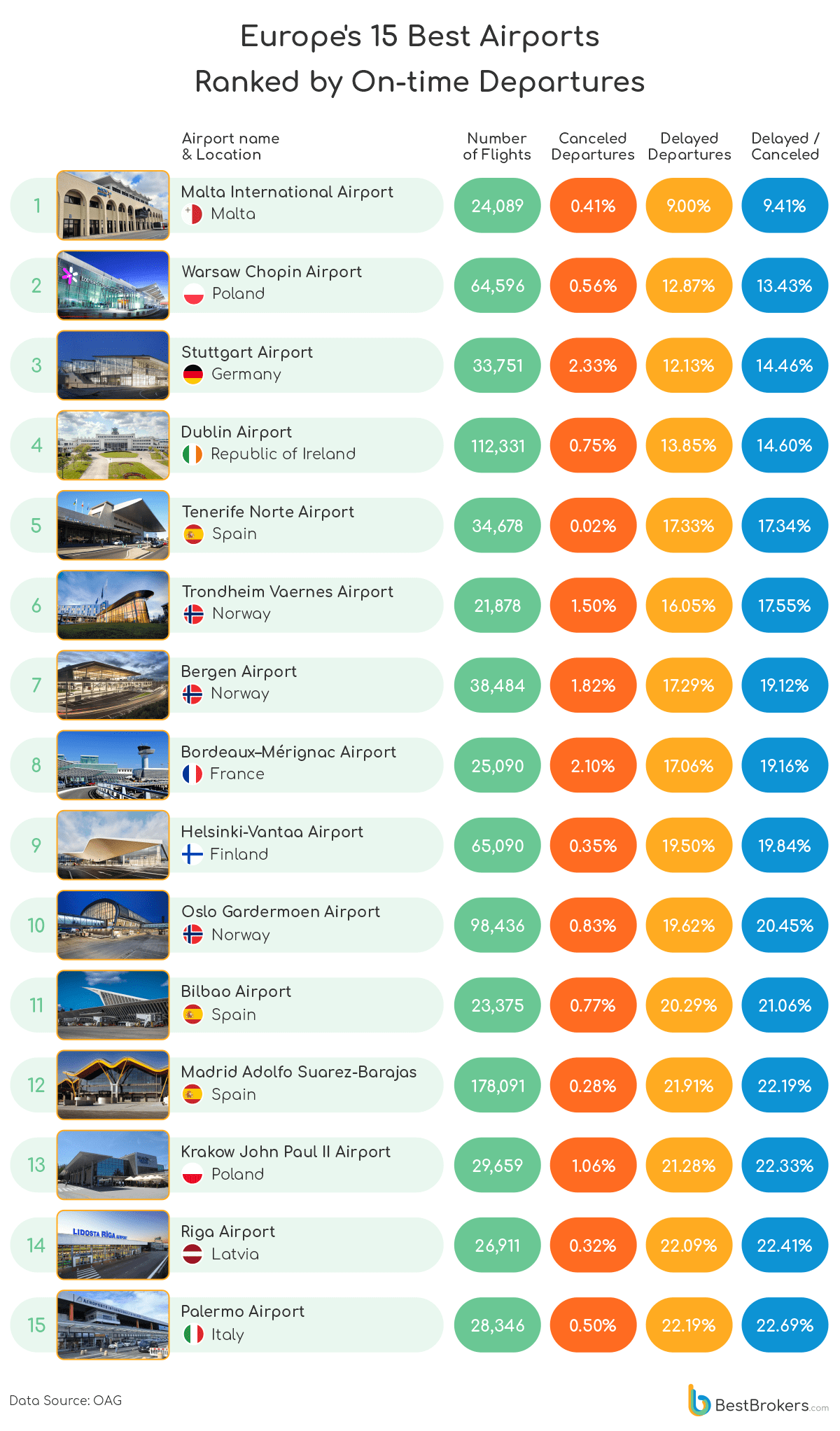Thousands of people have been returning to travelling and exploring the world over the past year after the pandemic-related restrictions on international travel, in particular, were finally lifted. But for many, it turned out that flying would not be the hassle-free experience they had looked for, with many flight delays and high cancellation rates at certain airports and with certain carriers.
Last year, the aviation industry in Europe saw a 10% increase in flights compared to 2022, with total traffic reaching roughly 92% of pre-Covid levels, according to Eurocontrol. Despite this recovery, the sector has faced many other difficulties including increased fuel prices, geopolitical conflicts, and labour strikes. While some companies in the aviation industry are seeing these issues as challenges that need to be overcome in order to improve, others seem to be using them as excuses.
Curious to see which airlines and airports struggled the most with their on-time performance last year, the team at BestBrokers did research into the latest statistics from OAG, a UK-based global travel data provider. We discovered that the least dependable airline in Europe for 2023 is Italy’s Air Dolomiti S.p.A. with a total of 43.56% of delayed or cancelled flights. The least punctual airport, on the other hand, is the Frankfurt International Airport with a barely 39.27% on-time departure rate.
The Worst Airlines in Europe

It has been reported that by the first half of 2023, all European flights were delayed by 15 minutes on average, exceeding the pre-pandemic numbers of 13.3 minutes. The aviation industry in Europe is going through challenging times with an increasing number of displeased employees, threatening strikes and demanding higher wages. Such were the Ryanair Brussels pilots who held a number of protests this summer, affecting scheduled routes and overall traffic.
Many of the airlines justified the delays with factors outside of their control such as limitations of air space and unfavorable weather conditions. European airlines are losing between 15–40% more time and expenses to avoid Russian airspace when flying to and from select Asian destinations amid the Russian-Ukrainian war. In addition, these reroutings interfere with flight schedules and sometimes lead to serious aircraft overlaps and delays.
In the summer, the flight control systems in the United Kingdom had a technical failure which led to hundreds of flight disruptions globally and more than 2,000 cancellations across the UK. The infamous ‘glitch’ was estimated to cost approximately £100 million in lost revenue for companies, as airlines followed up with demands for compensation over the next few days. The boom in travel demand over the summer was another reason for setbacks in the aviation industry. A lot of airlines were faced with airplane availability issues.
Italian regional carrier Air Dolomiti sits at the bottom of the chart with only 56.44% of its 33,415 flights in 2023 arriving on time. The airline, which is a subsidiary of Germany’s Lufthansa, flies passengers between several Italian destinations and Munich and Frankfurt. Among the worst-performing companies last year are also several major low-cost carriers (LCC) like Easyjet (6th worst in the ranking) and Wizz Air UK (7th worst), who are not exactly famous for their punctuality and comfort.
Two of Europe’s largest airlines also make a surprising entry in the list of the worst carriers of 2023, namely British Airways and Lufthansa. With only 60.67% of its flights arriving on time over the past year, British Airways is the fourth-worst European carrier with at least 20,000 flights per year. It has a cancellation rate of 3.14%, partly as a result of the flight control restrictions put in place after Christmas due to Storm Gerrit, which brought damaging winds and heavy rain to the UK. Lufthansa, on the other hand, saw nearly 30% of its flights in 2023 delayed and a 3.12% cancellation rate, making it last year’s 10th worst airline in Europe.
The Best Airlines in Europe

Despite the troublesome year, some airlines still managed to bring their A-game to the table and provide their passengers with timely arrivals. Germany’s Eurowings, yet another Lufthansa subsidiary, is the best-performing carrier on this ranking. We calculate that roughly 92.95% of its 156,350 flights last year arrived on time. Eurowings have been improving majorly over the last few years not only in terms of punctuality but also when it comes to efficiency and the general passenger experience. The airline is planning an increase in both fleet and destinations along with new software technology to be even more competitive.
Second on the list is TUI fly Belgium with 87.50% on-time arrivals, followed by the Spanish flag carrier Iberia with 84.81% of its flights being on time. Both airlines boast a low cancellation rate of 0.98% and 0.02%, respectively. The number two spot is affirmed by a strong increase in revenue throughout the past year, especially in Q4 2023 when it reported 40% more holiday bookings compared to 2022. The TIU group has invested in all of its airlines an innovative Machine Learning technology that reduces CO₂ emissions drastically and saves fuel as a part of their sustainability agenda.
Iberia secured 3rd place with just an edge over Norway’s Widerøe and although they had a strong performance last year, the Spanish airline started 2024 with several employee strikes, resulting in bad publicity and many cancelled or delayed flights.
Europe’s Airports Where Your Flight Is Most Likely to Be Delayed

Demand for air travel skyrocketed in 2023, especially during the summer which led to cramped airports, crowded air space and increased flight disturbance.
Contrary to the perception of the German nation being always on time, Frankfurt’s International Airport ranks as the worst airport in Europe due to its poor punctuality. Only 39.27% of all departures from it in 2023 were on time. Moreover, Munich International Airport lands in the 7th place with 48.09% on-time departures. Staff strikes and industrial action in Germany started in January and continued until March, resulting in the cancellation of thousands of flights and chaos at airports. In August, heavy rainfalls due to Storm Hans diverted dozens of planes and delayed hundreds of departures for a couple of days. A harsh winter followed, bringing another string of flight cancellations with it.
France and Belgium also have two entries each in our list of the 15 worst airports in Europe, while the UK has four. These countries were affected by horrific delays, thousands of cancellations and overloading in flights. The main reason behind this is similar to a lot of other European countries: labour strikes. Staffing shortages are also becoming an increasing concern for companies in the aviation sector throughout Europe.
The Best Airports in Europe

With 90.59% on-time departures over the past year, Malta International Airport is the best airport in Europe in terms of punctuality. Malta and its only airport near Valletta managed to surpass the 2019 air traffic stats with 7.8 million passengers in 2023. That figure represents a growth of 6.7% in 2023 compared to pre-pandemic levels and comes as a result of a continuous increase in tourist numbers.
The Warsaw Chopin Airport in Poland ranks second on our list with 86.57% of on-time departures. It serviced nearly 18.5 million passengers in 2023, exceeding its goal of 15 million and coming just 2% short of its best-ever figures reported in 2019. Because the airport is operating at its full capacity almost every year, the Centralny Port Komunikacyjny in Poland revealed plans for a new £7 billion, futuristic-looking ‘mega airport’ to be constructed by 2028.
Despite being home to two of the worst airports in Europe for 2023, Germany also made it to the top 3 list of last year’s best ones. The Stuttgart Airport ranks third with 85.54% of all departures in 2023 being on time. Although it saw its fair share of staff strikes last year the airport bounced back to finish the year strong. It is adding new routes with high demand from the public like Dubai and Manchester. The airport is also collaborating with Aurrigo International to introduce autonomous vehicles for cargo handling which will reduce emissions and improve the overall efficiency.
Other well-performing airports include the Dublin Airport, the Tenerife Norte-Ciudad de La Laguna Airport, and three airports in Norway; in Oslo, Bergen, and Trondheim.
Methodology
To come up with these findings we used statistics from OAG’s on-time performance data, during the period of January-December 2023 for Europe. To calculate the yearly on-time performance rating for each airline and airport we calculated the total percentage of delayed and cancelled flights for 12 months and compared it to the total number of flights each one had for the year. The data excludes airlines and airports with less than 20,000 flights for 2023.
